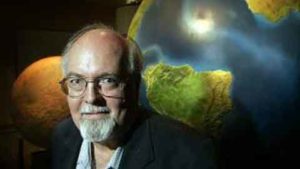B612’s 15th Anniversary by Clark Chapman
October 10, 2017
October 7 marked 15 years since B612 was formed to protect the Earth from asteroid impacts. Each day this week, five founding board members will each reflect on B612’s 15 years.
The post below is written by B612 founding board member, Clark Chapman. Clark is a planetary scientist whose research has specialized in studies of asteroids and cratering of planetary surfaces, using telescopes, spacecraft, and computers. He is recently retired from Southwest Research Institute (SwRI) in Boulder.
 The hazard of an asteroid or comet crashing into the Earth was a novel topic for me and a few colleagues during the two decades following the early-80s publication of the Alvarez hypothesis about an asteroid causing the mass extinction 66 million years ago and the subsequent first scientific conference on the Near-Earth Object (NEO) hazard organized by Eugene Shoemaker. People with different interests looked at NEOs in divergent ways. For some, it provided a possible argument for renewing Reagan’s “Star Wars” (Strategic Defense Initiative) program or justifying, for China, maintenance of nuclear weapons. Some religious cults considered reported asteroid near misses as heralding Armageddon. Aerospace engineers were inspired to study new ways to reach and interact with asteroids and comets. Space scientists became more interested in studying these “small,” previously largely ignored interlopers from the asteroid belt.
The hazard of an asteroid or comet crashing into the Earth was a novel topic for me and a few colleagues during the two decades following the early-80s publication of the Alvarez hypothesis about an asteroid causing the mass extinction 66 million years ago and the subsequent first scientific conference on the Near-Earth Object (NEO) hazard organized by Eugene Shoemaker. People with different interests looked at NEOs in divergent ways. For some, it provided a possible argument for renewing Reagan’s “Star Wars” (Strategic Defense Initiative) program or justifying, for China, maintenance of nuclear weapons. Some religious cults considered reported asteroid near misses as heralding Armageddon. Aerospace engineers were inspired to study new ways to reach and interact with asteroids and comets. Space scientists became more interested in studying these “small,” previously largely ignored interlopers from the asteroid belt.
However, scientific and engineering studies of the impact hazard were hampered by lack of funds. Managers of government research programs would point to a different program from theirs, or even to a different federal agency, as a better source of research funds for the new topic. So the limited research was done as a sideline and results published in “grey literature.” Nobody in the natural hazards research community, nor relevant national or international agencies (e.g. FEMA or the U.N.), were even aware of the NEO hazard.
Then the B612 Foundation was formed fifteen years ago with the nominal goal of demonstrating asteroid deflection. Its handful of activists, and the few dozen in its diaspora, mainly popularized and educated people about the topic, critiqued misguided governmental reports, and collaborated in national and international activities that would formally guide future research efforts to identify any dangerous NEO and develop logical end-to-end scenarios to mitigate any threat.
Thus the initially small Foundation was a major player in fostering the first regular international conferences on planetary defense, in informing the public about the topic in TV documentaries and articles in leading magazines, in testifying to Congress, in working alongside the Association of Space Explorers to encourage the United Nations to formally address the NEO threat, and in providing timely, independent, and rational responses to the “near misses” and similar events that occasionally made front-page headlines. A decade later, B612 greatly expanded its scope to address NASA’s continued inability to mount an adequate, space-based, and Congressionally mandated search for threatening NEOs; the resulting design of the Sentinel Mission remains a valuable blueprint for carrying out such a search.
Today, international interest in small solar system bodies and the hazard they pose is at an all-time high, and funding has increased dramatically (if inadequately to fund an actual space mission). Professional papers on the topic are now published in prestigious, peer-reviewed scientific and engineering journals. The public is ever more aware of bolides exploding in the night skies and there are occasional network soap operas about a threatened asteroid apocalypse. The NEO hazard is now generally recognized as a significant element in the field of natural hazards and emergency management. And new approaches to search for dangerous NEOs are beginning to address the failure, so far, for any nation to develop and launch a space-based search mission.
The impact hazard has moved away from the “Chicken Little” giggles of the 1990s to become a legitimate Homeland Security and U.N. concern, albeit at a lower level of priority than the threats of nuclear war, climate change, hurricanes, and earthquakes. The B612 Foundation has recently developed another approach for continuing research on the asteroid hazard via its Asteroid Institute, amid complementary efforts by a growing array of national and international groups of scientists and engineers. The Foundation will ultimately be successful as search efforts continue to reduce the near-term threat of a devastating impact and if, in the unlikely event a truly dangerous impact is forecast, the Foundation’s research will help to ensure that the impact does not happen.
Clark Chapman
Founding Board Member, B612















